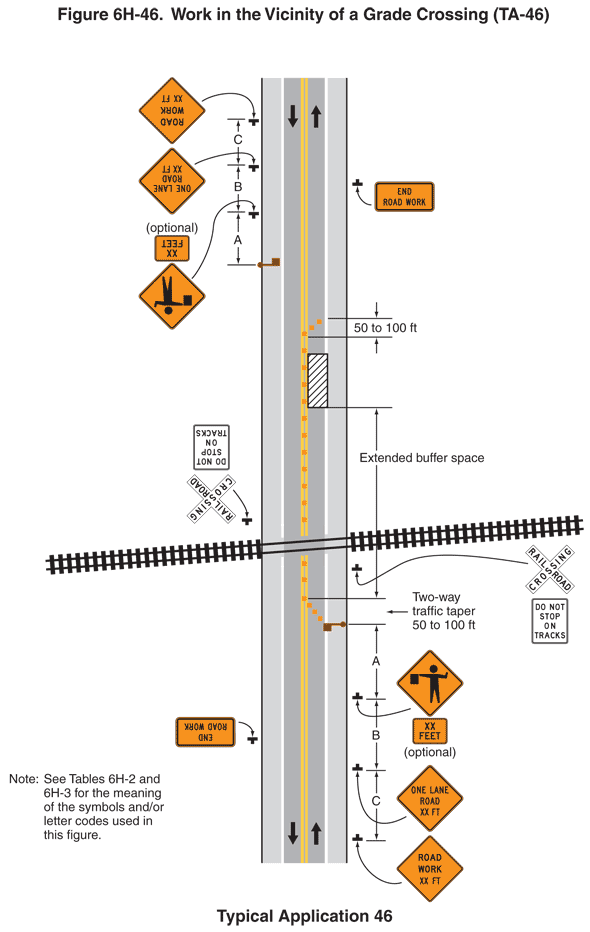2009 Edition Part 6 Figure 6H-46. Work in the Vicinity of a Grade Crossing (TA-46)

Figure 6H-46. Work in the Vicinity of a Grade Crossing (TA-46)
This figure illustrates an example of work in the vicinity of a grade crossing. A legend under the figure states that this is Typical Application 46. A note states "See Tables 6H-2 and 6H-3 for the meaning of the symbols and/or letter codes used in this figure."
This figure shows a vertical two-lane roadway with one lane of traffic in each direction. Downward-pointing black arrows in the left lane and upward-pointing black arrows in the right lane denote the direction of traffic. The opposing lanes are shown separated from each other by a solid double yellow line. A shoulder is shown on each side of the roadway. The shoulders are shown separated from the travel lanes by a solid white line. Just below the center of the figure, horizontal railroad tracks are shown crossing the roadway.
At the bottom of the figure and to the right of the shoulder of the right, northbound lane, a black inverted "T" is shown denoting a sign. It is shown as a diamond-shaped orange sign with a black border and the words "ROAD WORK XX FT" in black. Beyond this sign, at a dimensioned distance C, another sign is shown to the right of the shoulder. The sign is shown as a diamond-shaped orange sign with a black border and the words "ONE LANE ROAD XX FT" in black. Beyond this sign, at a dimensioned distance B, another sign is shown to the right of the shoulder. The sign is shown as a diamond-shaped orange sign with a black border and a black symbol of a flagger. It is shown above a horizontal rectangular orange plaque with a black border and the words "XX FEET," labeled optional. Beyond the flagger sign at a dimensioned distance A, a horizontal red flag symbol, denoting a flagger, is shown at the outside edge of the shoulder. At this point, a series of orange squares denoting channelizing devices is shown beginning at the solid white line between the shoulder and the right lane and tapering to the solid double yellow line between the two lanes. This two-way traffic taper is shown continuing for a dimensioned distance of 50 to 100 ft.
Just beyond this point, a sign is shown to the right of the shoulder of the right lane. The sign is shown as composed of two white horizontal rectangular signs placed one on top of the other to form an "x." In black letters, the word "RAILROAD" is on the piece running from northwest to southeast, and the word "CROSSING" is on the piece running from southwest to northeast, denoting a crossbuck. It is shown above a vertical white rectangular white sign with a black border and the words "DO NOT STOP ON TRACKS" in black. This sign is shown where the railroad tracks cross the roadway.
At the end of the two-way traffic taper, the channelizing devices are shown on the solid double yellow line between the lanes and continuing through an extended buffer space. This buffer space is shown ending at the work space, denoted by a vertical rectangle with diagonal black and white striped in the right lane. The channelizing devices are shown continuing to the left of the work space and then tapering to the right for a dimensioned distance of 50 to 100 ft. to the white line separating the right lane from the shoulder. Beyond this point, a sign is shown to the right of the right shoulder. The sign is shown as a horizontal rectangular orange sign with a black border and the words "END ROAD WORK" in black.
At the top of the figure, the same series of Road Work, One Lane Road, and flagger signs is shown to the outside of the shoulder of the left lane as well as the flagger symbol on the shoulder. Beyond the flagger symbol, the work space is shown in the northbound lane.
Beyond the work space, a white crossbuck above a Do Not Stop On Tracks sign is shown to the outside of the shoulder where the railroad tracks are shown crossing the roadway. Farther along the roadway, beyond where the channelizing devices in the northbound lane are shown ending, an End Road Work sign is shown to the outside of the shoulder.
